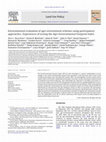Papers by Lone S Kristensen
Http Dx Doi Org 10 1080 01426397 2013 772959, Feb 13, 2014

Http Dx Doi Org 10 1080 00167223 2011 10669527, Apr 10, 2013
Rural landscapes are mainly maintained and changed through farmers' decisions and practices. As a... more Rural landscapes are mainly maintained and changed through farmers' decisions and practices. As a landscape manager the farmer has many different roles of which three roles related to the farm as a whole is investigated in this paper: producer, owner and citizen. Although most farmers take landscape decisions in all these three roles production based decisions are assumed to be more important for full time farmers than for hobby farmers who have their main income outside the farm and who may consider their farm more as a living place than as a production place. Based on a large survey carried out in Hvorslev, Eastern Jutland, Denmark in 2008 farmers' landscape practices are analysed in relation to their background, occupational status and view of their farms as a production place versus a living place. Altogether 377 farmers were interviewed and some comparisons are made to a similar survey in the same area in 1996. It was found that a significant proportion of farmers are hobby farmers who mainly see the farm as a living place and who to a large degree have different landscape practices than full time farmers have. The findings indicate that more research is needed to fully understand the reasons for and implications of the differences in landscape management practices.
Geografisk Tidsskrift-Danish Journal of Geography, 2011
Agricultural support payments in the EU are increasingly connected to compliance with environment... more Agricultural support payments in the EU are increasingly connected to compliance with environmental standards, through cross-compliance and "Good Farming Practice"-conditions. In this paper, this relatively new approach is analysed regarding targeting, compatibility with legal procedures, and effects on income and production. Compliance with standards is reinforced by more systematic controls and reductions of support payments. As farms are affected by

Humans occupy the space in different ways. The practices through which they deal with local bioph... more Humans occupy the space in different ways. The practices through which they deal with local biophysical potential to pursue their goals shape the space forming the “land”. We consider the land as the spatial entity whose character is defined by these human and natural interactions at a given time. “Land changes” occur when at least one of the following land components is modified: the shape of this spatial entity, its cover/use, the practices operated on it, its tenure or its accessibility. . Taken together several partial or individual changes may show common dynamics that can be named “land change transitions” (LCT). Intentional (i.e., planned) and unintentional changes coexist in the real world eventually driving these transitions according to local and global dynamics. Rethinking LCT is a way to address drastic and subtle land changes to understanding and steering them. Indeed, this is a twofold challenge for research. On the one hand research has to bridge the gap with the comp...
Geografisk Tidsskrift-Danish Journal of Geography, 2001
Agriculture in developed countries has, during the last four decades, undergone processes of chan... more Agriculture in developed countries has, during the last four decades, undergone processes of change commonly known as 'industrialisation'. The characteristics of these changes are well know and include the creation of economies of scale at the farm level, increased reliance ...

Multifunctional Land Use, 2007
ABSTRACT In contemporary sciences dealing with cultural landscapes, the concept of multifunctiona... more ABSTRACT In contemporary sciences dealing with cultural landscapes, the concept of multifunctionality has gained increasing attention in the last decade. The scientific literature displays several attempts to frame the concept (e.g DeVries 2000; Anon 2001; de Groot et al. 2002) but there is much frustration regarding proper sets of broadly based definitions and clear statements concerning the authors’ scientific points of departure (Anon 2001). Multifunctionality is on the one hand used to characterize the activities in the primary production sector, and the land use reflecting the material consequences of the various demands set by the society on land territories — these approaches relate to the agricultural understanding of multifunctionality. On the other hand, multifunctionality is used to characterize the landscape per se. The primary production sector (i.e. agriculture, forestry, horticulture and related land dependent activities) is considered having a primary or main function (production), and related joint productions, typically including a mix of material and non-tangible goods as well as a mix of private and public goods (externalities). Production of food and fibres is generally considered the primary products in this context, but the primary sector produces other material goods too, such as CO2 sequestration, groundwater recharge etc.

Geografisk Tidsskrift-Danish Journal of Geography, 2011
Rural landscapes are mainly maintained and changed through farmers' decisions and practices. As a... more Rural landscapes are mainly maintained and changed through farmers' decisions and practices. As a landscape manager the farmer has many different roles of which three roles related to the farm as a whole is investigated in this paper: producer, owner and citizen. Although most farmers take landscape decisions in all these three roles production based decisions are assumed to be more important for full time farmers than for hobby farmers who have their main income outside the farm and who may consider their farm more as a living place than as a production place. Based on a large survey carried out in Hvorslev, Eastern Jutland, Denmark in 2008 farmers' landscape practices are analysed in relation to their background, occupational status and view of their farms as a production place versus a living place. Altogether 377 farmers were interviewed and some comparisons are made to a similar survey in the same area in 1996. It was found that a significant proportion of farmers are hobby farmers who mainly see the farm as a living place and who to a large degree have different landscape practices than full time farmers have. The findings indicate that more research is needed to fully understand the reasons for and implications of the differences in landscape management practices.
Wageningen UR Frontis Series, 2004

Landscape and Urban Planning, 2013
ABSTRACT The rural spaces in Europe are undergoing complex processes of transition, at multiple s... more ABSTRACT The rural spaces in Europe are undergoing complex processes of transition, at multiple scales, and rhythms. In order to grasp and understand the changes occurring, the need emerges for new, conceptual approaches that make it possible to combine the different factors that shape spaces. Recent, literature on the multifunctional character of rural spaces and their transition pathways shows the, need for spatially based approaches, where the natural characteristics of a landscape are combined, with the socio-economic and cultural drivers that affect its changes. Experience shows how practical, questions on the changes affecting the rural, addressed by society to the scientific community, are of a, new character and require novel research approaches. This paper argues that landscape based, approaches can be useful basis for the required conceptual innovation. The paper presents and, discusses a set of examples of practice driven research developments, in contrasting regions of Europe. And it proposes a conceptual model which aims to contextualize empirical research driven by, problems set up in practice, and combining the ecological and structural dimensions with the socioeconomic, and cultural ones, all converging in the rural landscape, at multiple scales. The landscape, as, the spatial entity, in its material and immaterial dimensions, is presented in this paper as the most, comprehensive basis for the required step forward. This does not mean a disciplinary landscape, analysis revisited, but a new multi-scale and multi-domain place based approach, where the place is, the rural landscape.
Landscape Research, 2010
Page 1. Functional and Structural Changes of Agricultural Landscapes: How Changes are Conceived b... more Page 1. Functional and Structural Changes of Agricultural Landscapes: How Changes are Conceived by Local Farmers in Two Danish Rural Communities JØRGEN PRIMDAHL*, LONE KRISTENSEN*, ANNE GRAVSHOLT ...

Landscape Research, 2012
ABSTRACT Hunting represents an important activity in Danish rural landscapes. In this paper, we a... more ABSTRACT Hunting represents an important activity in Danish rural landscapes. In this paper, we analyse recent developments in farmers' management of the right to hunt and associated landscape activities in three agricultural regions based on surveys from 1995/96 and 2008. The results show that the total area on which farmers hunt has increased, especially the area on which the owner is the hunter. This indicates that interest in hunting is increasing, and the interest for hunting may play an increasing role as a landscape activity and as a motive to become a farm property owner. Concerning landscape management, non-hunters, surprisingly, seem to have a more game-friendly management practice than hunters. On the other hand, hunters own farms with forests and/or farms located in areas of high landscape heterogeneity more often than non-hunters. Local hunting associations play an interesting role in relation to non-owners' accessibility to hunting and such associations may play a significant role in the future management of the landscape as a commons.

Land Use Policy, 2012
The Agri-Environment Footprint Index (AFI) has been developed as a generic methodology to assess ... more The Agri-Environment Footprint Index (AFI) has been developed as a generic methodology to assess changes in the overall environmental impacts from agriculture at the farm level and to assist in the evaluation of European agri-environmental schemes (AES). The methodology is based on multi-criteria analysis (MCA) and involves stakeholder participation to provide a locally customised evaluation based on weighted environmental indicators. The methodology was subjected to a feasibility assessment in a series of case studies across the EU. The AFI approach was able to measure significant differences in environmental status between farms that participated in an AES and non-participants. Wider environmental concerns, beyond the scheme objectives, were also considered in some case studies and the benefits for identification of unintentional (and often beneficial) impacts of AESs are presented. The participatory approach to AES evaluation proved efficient in different environments and administrative contexts. The approach proved to be appropriate for environmental evaluation of complex agri-environment systems and can complement any evaluation conducted under the Common Monitoring and Evaluation Framework. The applicability of the AFI in routine monitoring of AES impacts and in providing feedback to improve policy design is discussed.
Journal of Environmental Planning and Management, 2011

Journal of Environmental Management, 2004
Recent landscape changes in a farmed landscape are analysed and related to farm and farmer charac... more Recent landscape changes in a farmed landscape are analysed and related to farm and farmer characteristics. It is assumed that farm and farmer characteristics serve as mediators of large scale or macro driving forces of change-in the present case, a changing farming context including demands for a more environmentally friendly farming practise and a reduced output. The results are based on multivariate analyses of data collected from structured interviews of 160 farmers in a case study area, in central Jutland, measuring 5000 ha. The analysis shows that farmers are highly involved in landscape changes. The investigated landscape changes include creation and removal of landscape elements as well as certain management changes. The most common activity was creation of elements: hedgerows, small woodlands and conversion of rotational arable land to permanent grassland, whereas removal of elements, mainly hedgerows and semi-natural grasslands, were seen less frequently. Management changes like abandonment of permanent grassland were widespread. The results indicate a general extensification of the land use and the authors interpret the results partly as an indication of a change from productivism to a more multifunctional agricultural regime. The observed landscape changes at the farm level show a low, but structured relationship with the current farm and farmer characteristics, meaning that landscape changes were undertaken by various farmers and on various farms. On a general level, however, the age of the farmer and the duration of farm ownership seem to have a major influence on the landscape changes.

Uploads
Papers by Lone S Kristensen